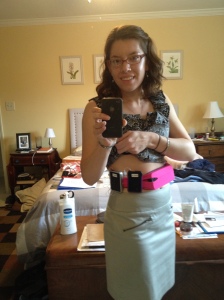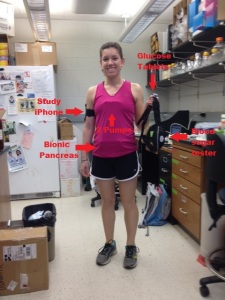It’s day 3, and this bionic pancreas is definitely still getting to know my body. I’ve noticed that it learned a little from Monday in that it is giving a bit less insulin, and subsequently a little less glucagon so I haven’t had as many nausea episodes. However, I went for a 3 mile run last night and I think this has thrown it for a loop today. Running usually makes me more sensitive to insulin (aka more low blood sugars) for at least the next 24 hours, so the bionic pancreas had to haphazardly adjust to this overnight last night and during the day today.
I had a pretty strong low during my run, since glucagon takes some time to kick in, and strenuous exercise can make my blood sugar drop faster than the glucagon can act. So I had to eat some glucose tablets (fast acting sugar) to bring my blood sugar back up. I also had a low this morning after breakfast that I had to eat some sugar for since the glucagon didn’t kick in fast enough. So, my bionic pancreas has some learning to do, but its only day 3 so I’m keeping the faith! It will learn over time that I still need less insulin than what it is giving, which will keep me from going low so often and needing a glucagon dose or a sugary snack. And also, I think the next prototype they’re working on will have a function to help prevent lows during or after exercise more effectively. This model doesn’t really have a function for that built in, so the study staff warned me to be careful about exercising and bring sugar with me, so I was more than prepared for that low.
I showed you the many things I need to carry on my person for the bionic pancreas, so I thought I’d put a few funny pictures in today to show you how I’ve integrated it (or attempted to, anyways!) into my outfits. I’m in job search mode right now since I’ll be graduating in several months, and of course I have a ton of networking events to go to in the next week that I need to look “professional” for. I went to a networking thing Monday night, and here was my get up for that:
Not too bad, I’d say. That pink running belt has been a lifesaver for carrying everything, so I’m glad I have that!
At that networking event, I was helping with the registration table. I was taking advantage of my time near an outlet to charge my pancreas (this thing drains batteries like crazy!) and I noticed a lady walk in with an insulin pump. I’ll often say to Nik, “That person we just passed – DID YOU SEE THEIR PUMP?? THEY HAVE DIABETES LIKE ME!” But he will totally not have noticed anything unusual about the person. Clearly I’m just too observant of other people’s waistbands! That being said, I don’t think I’m alone here – any diabetics reading this, don’t you agree that we have the uncanny ability to spot a diabetic from a million miles away if they’re wearing an insulin pump, or are carrying a tester case? And I definitely perk up if I ever pass a lone test strip on the ground that isn’t mine – I know there’s another diabetic about! We know there’s many other diabetics out there…and when have a diabetes encounter “in the wild,” its just exciting to feel that instant camaraderie, and instant respect for a total stranger that knows more about a particular aspect of my life than my own parents and friends and boyfriend can ever understand.
Anyway, I digress. So this very nice lady with the insulin pump walks up, and she instantly recognizes my bionic pancreas brick plopped on the table charging. She had seen pictures of it from previous trials, and it is pretty distinctive looking (since it is WAY bigger/thicker than any 2015 cell phone, and has “Boston University” written on it.) She was so excited about it, and we agreed to meet up after the event so I can show her all the parts, and tell her how it’s working. She was incredibly supportive, and really curious to know how it was working, and I have to say it is just so cool that the diabetes community is like that. So many type 1 diabetics are eager to participate in or contribute towards research, and we all want to know how current research is going. The discoveries being worked on in the diabetes research world are things we’ve been told about since we were diagnosed. When I was diagnosed, doctors said there would be a cure in 5 years. Five years later they said the same thing. Ten years later they said the same thing. A cure always seems to be 5 years away – and I think diabetics just get excited to see actual clinical trials going on for things like the bionic pancreas that are truly less than 5 years away, and that will make our lives easier. So meeting this kind lady “in the wild” was a fun and encouraging “diabetes encounter” for me!
So back to outfits! For my run yesterday, I spent quite a while figuring out how I’d carry everything with me in a comfortable manner. Here’s what I ended up with – I’m standing in my lab, getting ready to head out for my run:
My friend carried the blood sugar tester bag for me, but I managed to keep everything else on me, with no major issues. And I didn’t get too many glaring stares from passer bys about my pointy-looking abdominal area. Success!
I’m still hoping the pancreas keeps learning more about my body in the next few days because I’m still having lots of ups and downs. It is pretty cool not having to worry about calculating doses or (for the most part) dealing with lows, so I’m still enjoying the trial.
Louise



I guess the bionic pancreas isn’t good at dealing with different rates of changing blood sugars. It assumes you only have one rate of change. I would’ve expected it to be able to read your rate of change and increase or decrease the insulin it doses appropriately.
Actually sounds like a tough week. I’m anxious for you to line out!
LikeLike
The pancreas doesn’t assume I have one rate of change – it definitely can recognize a steeper or flatter rate of change and it acts differently in each case. One of the issues is that the pancreas only gets a reading that it can act on every 5 minutes from the CGM, so if I’m changing REALLY fast, like dropping during a run, it can only make decisions in 5 minute increments. It also will ramp up the doses of glucagon if it sees me dropping fast, but another issue is that glucagon takes time to act just like insulin. Glucagon isn’t equivalent to dosing me with sugar – it is a hormone that has to travel through my subcutaneous tissue all the way to the liver, signal to cells there, and tell them to dump glycogen into my body, which is THEN transformed into sugar for my cells. So sometimes a good old glucose tablet does the trick quicker!
LikeLike
Way to be bold Louise!
Thanks for sharing with the rest of the world your very cool experience of being in this clinical trial. It’s really gutsy of you to “pressure test” the system with your rigorous exercise, knowing that you’re likely to drop low, and knowing how we Type 1s go to such extreme measures to avoid dropping low.
Also, thanks for sharing the pictures of your bionic rig. We know that once this is FDA-approved it won’t be such a hassle, but thanks for suffering through the first generation devices in order to get the data to push this thing through. But what a pain now, going through the daily formulations of glucagon and keeping track of all your electronic baggage. Sure gives us a perspective on how fearfully and wonderfully we have been made.
It was a pleasure meeting you at the networking event too! Always a giddy joy to run into a fellow Type1, especially a fellow scientist. You are an ambassador for us all. Looking forward to your next posts.
Keep the faith, friend.
LikeLike